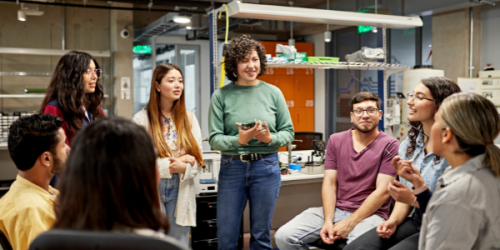Career and technical education (or CTE) teachers make up more than 10% of the high school educator workforce.1 Yet to date, CTE teachers—who teach subjects as varied as Health Sciences, Agriculture, Cybersecurity, and Engineering—have been the subject of very little research.
To better understand how CTE teachers’ preparation experiences predict their effectiveness, a new paper from CALDER examines the impact of CTE teachers who entered the profession through different pathways. Importantly, the authors looked at a range of non-test outcomes for students with and without disabilities. They found that CTE teachers from non-traditional pathways that emphasize work experience over degree attainment tended to produce more positive outcomes for all students, with disabilities and without.
States typically offer a traditional pathway to CTE licensure (different from other types of teacher licensure), wherein teacher candidates complete a four-year higher education program with a specialization in CTE. Many states also offer alternative training programs for aspiring CTE teachers that require limited formal preparation through higher education; roughly half do not require completion of a bachelor’s degree.2 Most states require work-based experience for CTE certification, though the required amount of work experience varies widely for these alternative pathways, ranging from 2,000 to 12,000 hours.
In Washington state, where this research was conducted, CTE teachers can enter the classroom through two routes. The first is a traditional pathway, wherein teachers must obtain a bachelor’s degree with coursework in a specific CTE specialty area, complete a state-approved CTE preparation program, and have 2,000 hours of paid occupational experience in their CTE area (working as a welder, for instance). The second pathway is a Business and Industry (B&I) CTE teacher licensure pathway, which doesn’t require a bachelor’s degree, but involves non-degree coursework and completion of 6,000 hours of paid work experience. At the end of the program, B&I pathway teachers are licensed for specific CTE courses, rather than broad areas (so one might be licensed, for example, to teach Veterinary Science, but not Agriculture courses as a whole).
Using data from Washington’s state longitudinal student data system, researchers found that high school students whose CTE teachers entered through the B&I pathway performed better on a range of non-test outcomes. Students with B&I teachers had roughly 6% fewer absences and 0.5% fewer disciplinary infractions than students whose CTE teachers completed a traditional certification program. Looking at the difference between students with and without disabilities, B&I teachers had an even more pronounced positive impact than traditionally-licensed CTE teachers on students with disabilities.
These findings suggest that if schools can attract CTE teachers with industry experience, they may see additional positive outcomes for students, especially those with disabilities. (Though without longer-term research, it remains to be seen how these positive effects impact students’ future education and workforce outcomes—a particularly important measure of success in CTE, given its central goal of supporting students to transition into specific careers.) To support this work, states can pull from federal workforce dollars through the Perkins Act to prepare and recruit CTE teachers—and the federal government recently released guidance for states on how to use dollars for this purpose.
More like this

Teacher prep matters; let’s start acting like it
Policymakers are overlooking teacher prep as a critical force in promoting teacher quality and better outcomes for students.

Are some teachers more effective than others at teaching students with disabilities?
Every family sends their child off to school, hoping the teacher will effectively meet their child’s unique needs.

The emerging science on predicting if a teacher will be effective
Researchers have spent decades investigating the most valid predictors and measures of teacher quality, with one of the hopes being that school districts will know exactly what to look for when hiring new teachers.
Endnotes
- U.S. Department of Education (2012). National Center for Education Statistics, Schools and Staffing Survey (SASS), Public and Private School Teacher Data Files, 2011–12.
- Zirkle, C. J., Martin, L., & McCaslin, N. L. (2007). Study of state certification/licensure requirements for secondary career and technical education teachers. National Research Center for Career and Technical Education.

